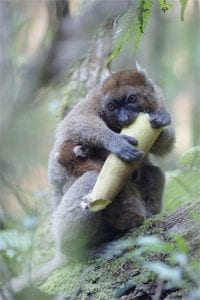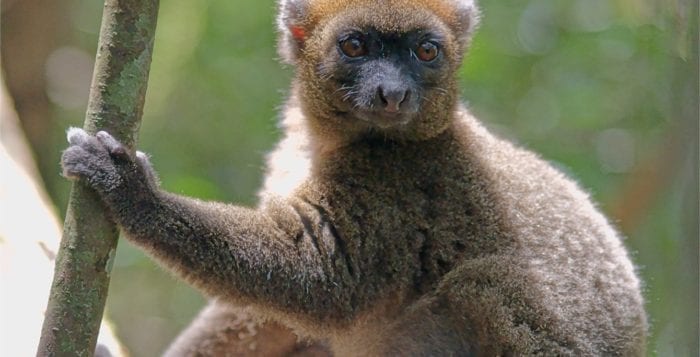By Daniel Dunaief
An elusive primate is living on a shrinking island within an island. The greater bamboo lemur, which is one of the world’s most endangered primates, now inhabits a small section of Madagascar, where it can find the type of food it needs to survive.
The greater bamboo lemur, which was one of numerous lemurs featured in the 2014 iMax movie, “Island of Lemurs: Madagascar,” is finding that the time when it can eat the most nutritious types of bamboo is narrowing each year amid a longer dry season.

In a publication last week in the journal Current Biology, Patricia Wright, the founder of Centro ValBio research campus, driving force behind the creation of Ranofamana National Park and a distinguished professor of anthropology at Stony Brook University, along with several other researchers, including Jukka Jernvall from the University of Helsinki and Alistair Evans from Monash University, showed that the population of lemurs is threatened by a changing climate. The bamboo that sustains the greater bamboo lemurs depends on water to produce shoots that are higher in nutrition.
Indeed, when the rains come, the new bamboo shoots are “filled with protein,” said Wright. Jernvall, however, predicted that the driest season will get longer by a day each year. By 2070, rains necessary for bamboo growth and greater bamboo lemur survival will be delayed by as much as two months.
This is problematic not only for the current generation of greater bamboo lemurs but also for the more vulnerable younger generations, who need their lactating mothers to eat more nutritious bamboo to help them grow. Bamboo shoots typically come up from the ground about two weeks after the rains begin, in the middle of November. Bamboo lemurs, whose annual clocks are set to the rhythm of an island off the southeast coast of Africa that is the size of California, are born around the time of these bamboo-shoot-producing rains.
“Any village elder will tell you that the rains used to come at about Nov. 15 and continue until March 15,” Wright said. “That’s the way the world was, even in the 1980s and 1990s and probably many years before that. Suddenly, we started to get some evidence of climate changes and periods of a longer dry season.”

Wright is currently in Madagascar, where she says there is a drought right now. “No water for our research station means no electricity since we are near a hydroelectric power plant,” she explained by email. In fact, in some years, the rains start as late as January, which reduces the food offerings for the mother lemur, who weighs about 6.5 pounds, and her offspring, who need considerable nutrition to grow from birth weights Wright estimates are less than half a pound. The lemur mother “has to have nutritious shoots to feed her baby milk,” Wright said. “She can survive on leaves and trashy stuff in the culm, but she can’t raise her babies” on it.
Wright and Jernvall worked together in 2005 on a study of climate and another type of lemur called sifakas, whose name comes from the alarm sound it makes. In their earlier work, Wright and Jernvall found that aging sifakas with worn teeth could still produce offspring, but that their infants typically died if the weather was dry during the lactation season, Jernvall explained in an email.
“This alerted us about the potential impact of climate change,” he continued. “The bamboo lemur were an obvious concern because they are critically endangered and because they eat the very tough bamboo.”
Jernvall said the work on bamboo lemurs combines Wright’s efforts in Madagascar with climate modeling he performed with Jussi Eronen at the University of Helsinki and an analysis of dental features conducted by Evans and Sarah Zohdy, who is currently at Auburn University. Stacey Tecot, who is on sabbatical from the University of Arizona, also contributed to the research.
Wright believes some efforts can help bring these bamboo lemurs, who survive despite consuming large amounts of cyanide in their bamboo diet, back from the brink. Creating a bamboo corridor might improve the outlook.
Growing bamboo would not only benefit the lemurs, who depend on it for their survival, but would also provide raw materials for the Malagasy people, who use it to construct their homes, to build fences and to cover their waterways.
Bamboo corridors could be a “win-win situation,” where scientists and local communities grew and then harvested these hearty grasses, Wright continued. She has started a bamboo pilot study near one of the small populations of lemurs and hopes the lemurs can expand their range.

Like other animals with unusual lifestyles, the greater bamboo lemurs offer a potential window into an unusual adaptation. Through their typical diet, lemurs consume a high concentration of cyanide, which is stored in the bamboo. Understanding the bamboo lemur could provide evidence of how one species manages to remain unaffected by a toxin often associated with spies and murder mysteries.
As a part of her efforts to improve the chances of survival for this lemur, Wright is considering moving some lemurs to a protected area. She needs permission from Madagascar officials before taking any such actions and recently met with Madagascar National Park official to discuss such remediation efforts.
In Madagascar, Wright said observing the bamboo lemur is challenging because it is such a “cryptic animal.” She has sat beneath a tree where a lemur is hiding for seven hours waiting for it to emerge, watching as a lemur brought in its legs and curled up its body to hide from the scientist’s inquisitive eyes. “I’d get really hungry, so they would win and I would leave,” Wright recalled.
She suggests that the data in the Current Biology article demonstrates the urgency to take action to protect these primates. “We are trying our best to help the bamboo lemur not go extinct,” she said. “Bamboo corridors should help, but we may have to irrigate the bamboo during November to January.”





